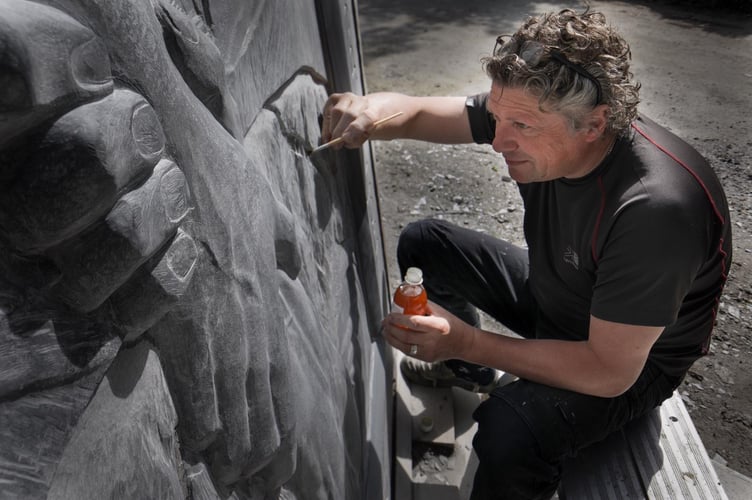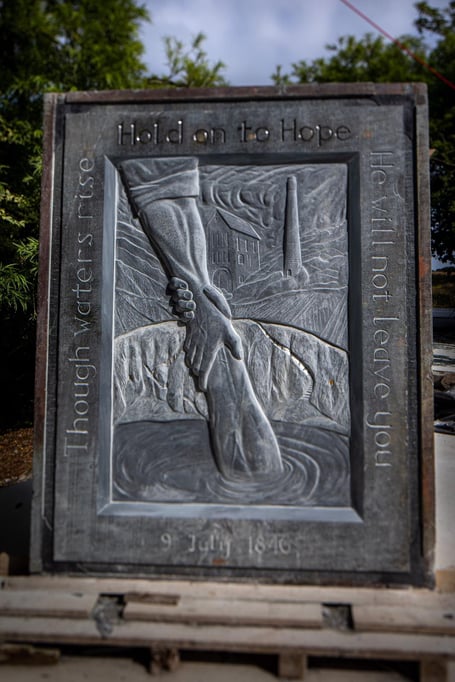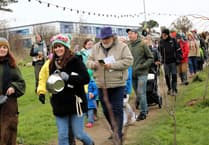A vast slate sculpture created to commemorate the worst mining disaster in Cornish history is being unveiled at a railway attraction in St Newlyn East on Friday.
The memorial sculpture is being installed at its new home at the site of the tragedy at East Wheal Rose Mine at 11am, which is where 38 men and boys lost their lives in 1846 and is now home to Lappa Valley.
One more life was lost at nearby North Wheal Rose Mine during the flash floods, whilst heroic rescue efforts it is claimed saved as many as 161 lives.
A setting and blessing ceremony will take place for the slate carving, which measures 7ft by 5ft and weighs over a tonne.
The inscription reads ‘East Wheal Rose Mine 1846. 39 lives lost. 161 lives saved. Hold on to hope; though the waters may rise, he will not leave you.’
The project was originated by Cornish researcher and historian Barry West, who with some support ensured in depth research was undertaken to shed light on the disaster and organised three days of events to commemorate the anniversary of the tragedy.
The sculpture commission was sponsored by Trewithen Estate, Treseren and Barry West.
Sculptor Benjamin Dearnley won the commission for the sculpture with his design ‘Hold on to Hope’ which features a central striking image capturing a rescue effort of one man pulling another from the waters that flooded the mine on that fateful day over 175 years ago.

Benjamin said: "It has been a great honour and privilege to work in this amazing open air studio in the grounds of Captain Middleton’s house.
“I feel a sense of place has become imbedded into the sculpture, which conveys both a message of hope for us all in today’s world as well as commemorates the sad loss of life of the 39 men and boys in that disaster 175 years ago."
The sculpture was carved in the grounds of Shepherds House, which is now home to the award-winning wedding venue Treseren.
Built as a Mine Captain’s House in the early 1800’s and home of Captain Middleton who oversaw the rescue effort during the disaster.
The once blank piece of Cornish slate originated from the farm of Brian Furse and family in Poundstock has evolved into a striking piece of art.
The account of the tragedy in The Royal Cornwall Gazette newspaper of 1846 read: “Between 1 and 2pm on Thursday 9th July, one of the most awful thunderstorms ever known had broken near the mine. Dense, heavy purple-black clouds… poured down floods of rain. The surface of the mine was awash within minutes and the water rushed northwards, the land sloping that way.
“As it did so it broke the shafts and ‘rushing down into the levels … loosened and broke the timbers beneath, the consequence of which was the falling in of some other parts of the mine northwards.”
Local company MacSalvors who originally moved the stone to the open-air studio for carving, have once again donated a lorry and crane and their expertise to oversee the move of the sculpture from Treseren to East Wheal Rose at Lappa Valley. The memorial sculpture will need to be careful manoeuvred into its new home.

.jpeg?width=209&height=140&crop=209:145,smart&quality=75)



Comments
This article has no comments yet. Be the first to leave a comment.